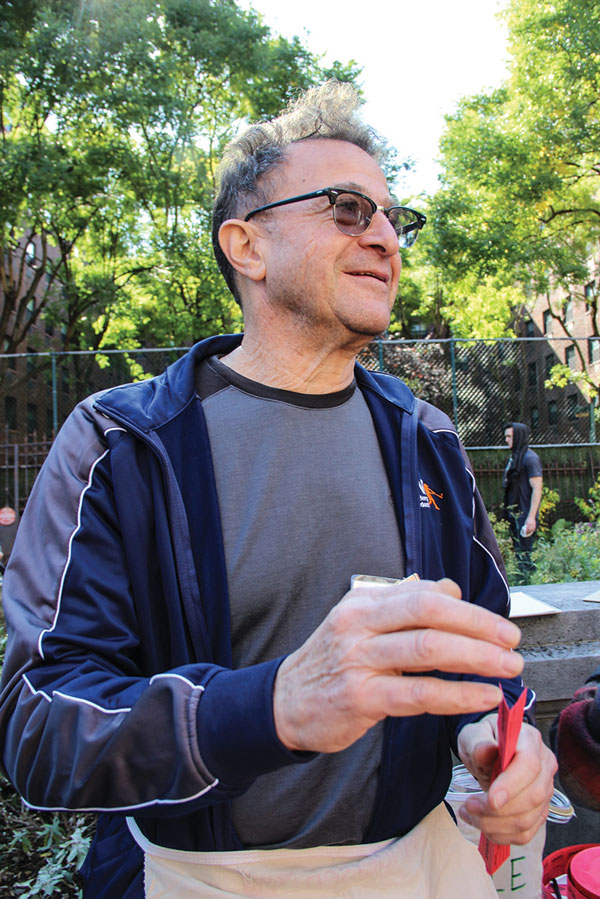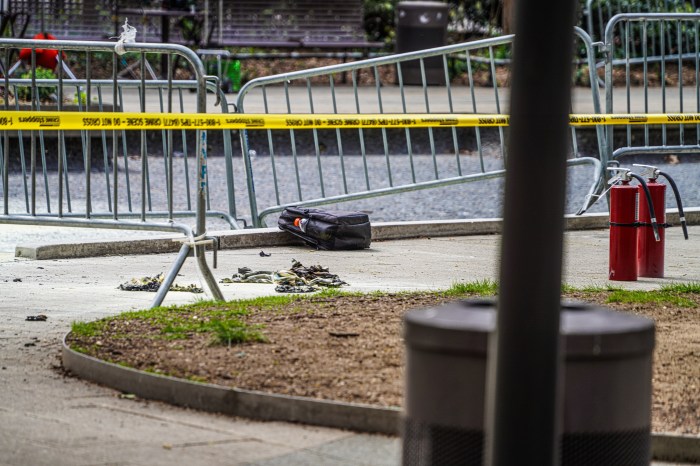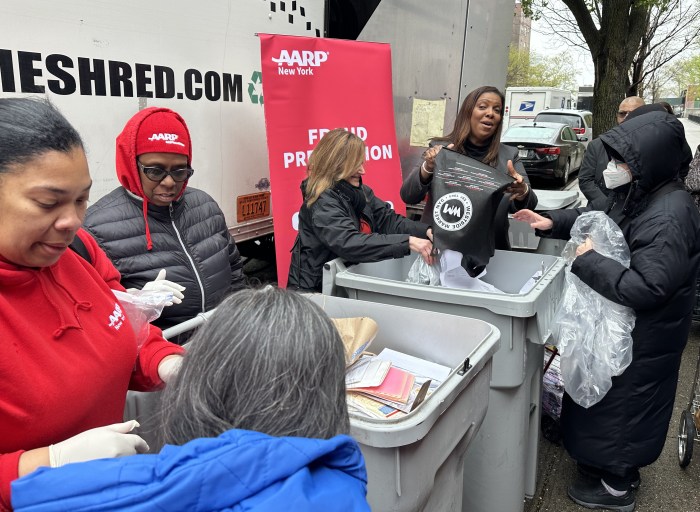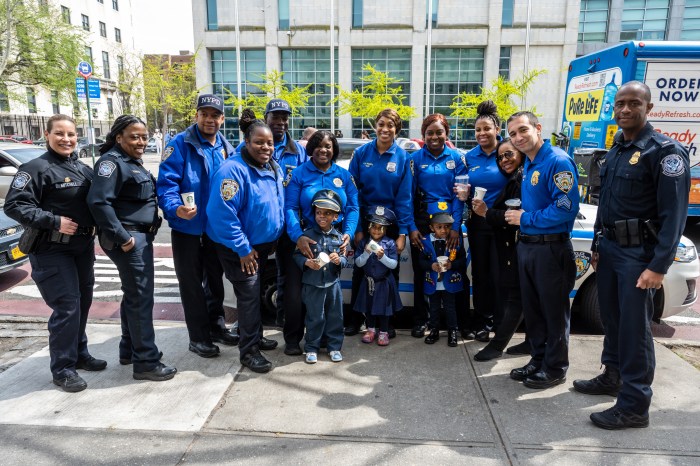BY LINCOLN ANDERSON | When Tobi Bergman was a young boy growing up Downtown, he and his friends used to play punchball in Washington Square Park — like baseball except using a fist rather than a bat to self-hit a tennis ball. They played on the asphalt surface in the park’s then-bus turnaround. The buses didn’t go too fast, so it wasn’t dangerous. But, then again, it wasn’t a real field.
The Village had fewer permanent green spaces back then. It would be decades until the dream of sports fields on Pier 40 — in a movement organized by Bergman — would become a reality.
Elected chairperson of Community Board 2 in November, Bergman brings a wealth of experience to the position, acquired over his 18 years as a member of the Village board, on top of having grown up here.
He sat down with The Villager recently to touch base on key issues that C.B. 2 is working on now — and will be working on in the near future — and also to share a bit more about himself and his background.

He had just been at a meeting with local education advocates and School Construction Authority officials about the new middle school planned in a converted former state office building at 75 Morton St. The agency had finally relented and agreed to the community’s call for a more functional “gymatorium” — a combination gym, theater and auditorium — by dropping its plan to outfit the space with 800 individual movable chairs.
“S.C.A. is now saying they will put in the retractable seating that we wanted,” Bergman explained. “Putting 800 chairs in and out would be a problem.”
The community also had initially pushed for a small gym and a small auditorium separate from each other, but came around to seeing it S.C.A.’s way that a larger, combined “gymatorium” would “give more space,” Bergman noted.
“We were persuaded this was the way to go,” he said.
On Mon., May 11, the S.C.A. will present the latest plans for 75 Morton to the community. The task force, of which Bergman is a member, will continue to meet and offer input as part of the ongoing process.
As for Pier 40, the aging 14-acre structure at W. Houston St. and the sale of its unused development rights for the anticipated redevelopment of the St. John’s Center site across the highway comprise a massive item on C.B. 2’s future agenda. But the city, the Hudson River Park Trust and the expected developer — Atlas Capital Group — are all reportedly moving slower than had been hoped for in the process, under which the money from the air rights’ sale would be funneled back into Pier 40 to repair its badly corroded underwater support piles.
Details of the preliminary Atlas plan were leaked last November, when handwritten notes of a meeting between the developer’s reps and Borough President Gale Brewer became public. The notes said, for example, that the project, at its highest point, would include a tower more than 400 feet in height, and also have senior and affordable housing — though none of it with river views — along with market-rate housing, a hotel and more.
Asked what he thought of those specs, Bergman would only say that he supports the concept of selling the waterfront park’s unused development rights to help fund the park, particularly the ailing “sports pier.”
“I’m in favor of the idea,” he said. “I’m not in favor of a plan I haven’t seen yet.
“I think it’s a good idea,” he said of the state law, passed in late 2013, that allows the park to cash in on its air rights. “Developers have already obtained a huge benefit from Hudson River Park,” he noted. In other words, it’s high time for the park to reap some of that “New Gold Coast” value that it clearly helped generate.
As for what should be included in the St. John’s project — senior housing? a school? a hotel? — he offered, “I would say everything. Everything should be in the mix. This project needs to bring many good things.”
As for the de Blasio administration’s “Zoning for Quality and Affordability” plan, as The Villager recently reported, Bergman — like other community activists — strongly opposes the “one size fits all” initiative. Under the city’s plan, contextually zoned areas in the West and East Village could see building-height caps raise anywhere from 5 to 15 feet to — if senior or affordable housing is included — 25 feet.
“This is affecting all future contextual zoning,” Bergman said. “It will result in taller buildings. The contextual zoning that was put into place, that we have now, was the result of years of community planning.”
Having grown up in Downtown Manhattan, Bergman, 68, has seen the community go through many changes.
He was born on the Upper West Side, but when he was age 4 his family moved to the Lower East Side, and he’s mostly lived Downtown since then, and on the Lower West Side since the 1980s.
His father was a typesetter whose work included producing influential publications like the Evergreen Review, founded by Grove Press’s Barney Rosset.
Bergman attended City and Country School, in the Village, one of whose signature teaching techniques is for young students to work with large wood blocks to create models of the city’s bridges and buildings. (So perhaps it’s not so surprising that the adult Bergman would become drawn to large-scale monolithic structures, like Pier 40.)
“The Village was my hangout,” Bergman recalled of his youth. “After school, we went to Washington Square Park. We walked around the Village.”
His good friends growing up were the twin sons of Shirley Hayes, the grassroots activist who led the fight to get auto traffic out of the park.
“Robert Moses wanted to build an expressway through the park, from Fifth Ave. to Canal St.,” he said. “Everyone wanted to keep the expressway out of the park, but Shirley Hayes demanded buses and cars out of the park. Tony Dapolito himself said that she was asking for too much,” Bergman recalled of the late “Mr. Parks” of C.B. 2, one of his mentors.
Bergman would go on to college at the University of Wisconsin. When he graduated and returned to the city, they had just finished renovating Washington Square Park.
“I was upset about it,” he remembered, but added that he eventually came to like it.
As for the park’s latest renovation, he said, “It’s working…except for those four trees in the small pits toward the middle that keep dying. People seem to be enjoying it — that’s how you measure success.”
At the same time, he said, “The community was told it was going to be a refurbishment. And then they were presented with a plan that was more drastic than anyone had imagined. That part of the process was very poorly done. I argued in favor of the renovation.”
In terms of recreation, the Village has seen a boom in youth sports, and Bergman and his fellow parent allies have played a big role in making that a reality.
“For most of my life, there was really no space,” he said. “J.J. Walker Field, Seravalli Playground — everywhere you went, it was adults, bar leagues. It was really hard to get in there.”
It all started with Jon Bennett, the founder of the Greenwich Village Little League.
“He had a couple of girls,” Bergman recalled. “He wanted to go out and play on the fields. They told him, ‘You need a permit,’ and then that he needed insurance. The only way he could get insurance was through Little League.”
Dapolito was able to persuade the Parks Department commissioner to give the local children J.J. Walker for three hours on a Saturday.
“That first day, 200 kids and family members showed up,” Bergman said. “The Parks commissioner was there, and said, ‘O.K., you got the whole day from now on.’ ”
Eventually, the families got the field, at Clarkson and Hudson Sts., on Sundays, too.
The C.B. 2 chairperson has two grown sons, Patrick, a journalist, and Mackey, the director of Steady Buckets, a free youth basketball league.
When G.V.L.L. began, J.J. Walker was a dirt field, variously prone to puddles and sandstorms. Before games, they would have to ask the homeless people who slept on the seating to leave.
Before long, the league got artificial turf installed at J.J. Walker, which is also the surface for the sports fields at Pier 40.
Bergman was a leading member in the struggle to get playing fields on Pier 40. A rooftop field on the sprawling Lower West Side pier was won just before the turn of the century, after the community sued the pier’s previous owner, the state Department of Transportation, for failing to make good on its promise to provide recreational space on the pier.
As the Pier 40 lawsuit was being settled, in 1997, Bergman founded P3 (Pier Park & Playground Association) to push for more youth athletic fields in the C.B. 2 area.
Then, in 2004, after a request for proposals (R.F.P.) to find a developer to fix up the crumbling pier failed, the Trust agreed to create a 400-foot-by-400-foot “interim” field in the pier’s courtyard. It rapidly became a treasured community amenity.
Although many see Bergman as the father of the Pier 40 ball fields, he doesn’t claim the idea was originally his.
“I don’t know who first thought of putting ball fields at Pier 40,” he told The Villager. “The idea was introduced to me by Vince McGowan. I just helped organize parents to support it.”
McGowan was vice president for operations for the Hudson River Park Conservancy, the Trust’s predecessor.
It’s not surprising that Bergman has been a parks expert — and a former Parks Committee chairperson — on the community board. He was chief of operations for Central Park from 1983 to 1995.
Before that he was director of operations for the Brooklyn Museum.
However, for this article, Bergman said that he didn’t want to rehash the various plans he’s supported or even personally pitched — along with local youth leagues — for Pier 40 in the past. At one point, about a dozen years ago, he even flew to France to work with an architect on how best to incorporate playing fields into a proposed redesign by C&K Partners for the pier. More recently, the youth leagues supported the idea of building housing first on, and then next to, Pier 40 to raise revenue for the pier.
Within the past couple of years, saying his help was no longer needed, Bergman stepped down from his position at P3, whose office is based on Pier 40.
While sports fields have been on the rise, local diversity has been on the wane.
“We have in C.B. 2 a half dozen great neighborhoods or more,” Bergman said. “It’s very difficult when you see your neighborhood change. The biggest harm to our neighborhoods, as I see it, is it’s become less diverse — economically, ethnically and in all diversity. We had Italians and Irish. The whole West Side was Irish. There were a lot of Portuguese and there were artists. Everyone was here. That was the biggest loss.
“On the other hand, parks and playgrounds were pretty rundown. We didn’t have Hudson River Park. Now we’re getting the Whitney. I still can’t imagine living anywhere else.”
Speaking of parks, the fate of the “open-space strips” along LaGuardia Place and Mercer St. — which were declared “impliedly parkland” by one state judge — will determine, in large part, whether the N.Y.U. 2031 mega-project sinks or floats. The case is set to be heard by the state’s highest court, the Court of Appeals.
“Let’s keep our fingers crossed,” Bergman said. “I think there’s still a great chance that this will be stopped. I don’t see that you can call those anything other than parks — and if they’re parks, it needs to go to the state Legislature. Hopefully, the court will do the right thing.”
Bergman is upset that residentially rezoning Hudson Square doesn’t seem to be panning out in terms of creating affordable housing. Developers can get a height bonus by voluntarily including affordable units in their projects, but are choosing not to do so.
“We got sold a bill of goods,” Bergman charged.
He’d also like to see Trinity Real Estate get moving on developing its residential tower in Duarte Square, at Sixth Ave. and Canal St. Not only will this project contain a new public school in its base, but it “will help connect Tribeca and Hudson Square,” he noted.
Meanwhile, that lot’s various interim uses, from food trucks to, more recently, Nike’s Zoom City Arena for NBA All-Star weekend, have been “one disaster after the next,” he complained.
Bergman and his wife recently sold their Watts St. building, which was in the rezoned Hudson Square district, and the property will likely be incorporated into a larger development project on Varick St.
Another concern is the influx of large chain stores and restaurants.
“People want to rent to chain stores — even if smaller stores can afford it — because these are known as ‘high-credit’ stores,” he noted. “It’s good for the landlord. It allows an owner to take more equity out of a building. It’s a little like redlining, in my mind, because banks are encouraging landlords to rent to chains. If you think about loss of character in our neighborhoods, for many, many years, chain restaurants were not so prevalent. Now they’re taking over.”
In addition, he said, the Department of Buildings is not enforcing an existing prohibition on retail uses of more than 10,000 square feet in Soho.
R.E.I. is an exception since sporting uses are allowed, he said. But it should be applied against Topman, Uniqlo and Bloomingdale’s, according to Bergman.
“D.O.B. apparently fails to enforce the requirement,” he said.
Bergman supports Citi Bike.
“It surprised everybody how big these bike racks were,” he admitted. “But I think most people are used to them by now.”
As for perennial issue of bars and quality of life, Bergman said it’s a delicate balance.
“What makes New York different from the suburbs is we have life on our streets,” he noted. “Stores bring life to our streets. Jane Jacobs felt bars brought life to the streets. I do, too. People need to sleep at night. On the other hand, it’s the city that never sleeps. I like to walk down streets at night that have activity. I don’t like to walk down streets at night where people are behaving badly. It’s a very difficult balance. I don’t like walking through Soho at night: There’s no life, everything closes down and it’s dead.
“We have to accept both: a livable neighborhood and a special neighborhood with special activities,” he said. “Places that play music can be the worst, but they also contributed a lot to the cultural existence of our neighborhood. The ’60s wouldn’t have happened without loud music — and sometimes bad music.”

















